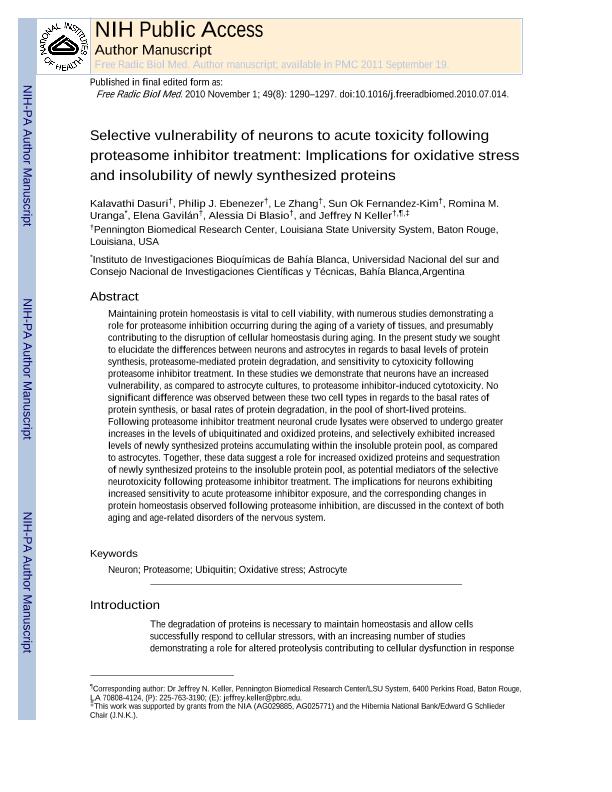Mostrar el registro sencillo del ítem
dc.contributor.author
Dasuri, Kalavathi
dc.contributor.author
Ebenezer, Philip J.
dc.contributor.author
Zhang, Le
dc.contributor.author
Fernandez Kim, Sun Ok
dc.contributor.author
Uranga, Romina Maria

dc.contributor.author
Gavilán, Elena
dc.contributor.author
Di Blasio, Alessia
dc.contributor.author
Keller, Jeffrey N.
dc.date.available
2018-04-17T19:06:34Z
dc.date.issued
2010-11
dc.identifier.citation
Dasuri, Kalavathi; Ebenezer, Philip J.; Zhang, Le; Fernandez Kim, Sun Ok; Uranga, Romina Maria; et al.; Selective vulnerability of neurons to acute toxicity after proteasome inhibitor treatment: Implications for oxidative stress and insolubility of newly synthesized proteins; Elsevier Science Inc; Free Radical Biology and Medicine; 49; 8; 11-2010; 1290-1297
dc.identifier.issn
0891-5849
dc.identifier.uri
http://hdl.handle.net/11336/42355
dc.description.abstract
Maintaining protein homeostasis is vital to cell viability, with numerous studies demonstrating a role for proteasome inhibition occurring during the aging of a variety of tissues and, presumably, contributing to the disruption of cellular homeostasis during aging. In this study we sought to elucidate the differences between neurons and astrocytes in regard to basal levels of protein synthesis, proteasome-mediated protein degradation, and sensitivity to cytotoxicity after proteasome inhibitor treatment. In these studies we demonstrate that neurons have an increased vulnerability, compared to astrocyte cultures, to proteasome-inhibitor-induced cytotoxicity. No significant difference was observed between these two cell types in regard to the basal rates of protein synthesis, or basal rates of protein degradation, in the pool of short-lived proteins. After proteasome inhibitor treatment neuronal crude lysates were observed to undergo greater increases in the levels of ubiquitinated and oxidized proteins and selectively exhibited increased levels of newly synthesized proteins accumulating within the insoluble protein pool, compared to astrocytes. Together, these data suggest a role for increased oxidized proteins and sequestration of newly synthesized proteins in the insoluble protein pool, as potential mediators of the selective neurotoxicity after proteasome inhibitor treatment. The implications for neurons exhibiting increased sensitivity to acute proteasome inhibitor exposure, and the corresponding changes in protein homeostasis observed after proteasome inhibition, are discussed in the context of both aging and age-related disorders of the nervous system.
dc.format
application/pdf
dc.language.iso
eng
dc.publisher
Elsevier Science Inc

dc.rights
info:eu-repo/semantics/openAccess
dc.rights.uri
https://creativecommons.org/licenses/by-nc-nd/2.5/ar/
dc.subject
Neuron
dc.subject
Proteasome
dc.subject
Ubiquitin
dc.subject
Oxidative Stress
dc.subject
Astrocyte
dc.subject
Free Radicals
dc.subject.classification
Otras Ciencias Biológicas

dc.subject.classification
Ciencias Biológicas

dc.subject.classification
CIENCIAS NATURALES Y EXACTAS

dc.title
Selective vulnerability of neurons to acute toxicity after proteasome inhibitor treatment: Implications for oxidative stress and insolubility of newly synthesized proteins
dc.type
info:eu-repo/semantics/article
dc.type
info:ar-repo/semantics/artículo
dc.type
info:eu-repo/semantics/publishedVersion
dc.date.updated
2018-04-12T14:25:03Z
dc.journal.volume
49
dc.journal.number
8
dc.journal.pagination
1290-1297
dc.journal.pais
Estados Unidos

dc.description.fil
Fil: Dasuri, Kalavathi. State University of Louisiana; Estados Unidos
dc.description.fil
Fil: Ebenezer, Philip J.. State University of Louisiana; Estados Unidos
dc.description.fil
Fil: Zhang, Le. State University of Louisiana; Estados Unidos
dc.description.fil
Fil: Fernandez Kim, Sun Ok. State University of Louisiana; Estados Unidos
dc.description.fil
Fil: Uranga, Romina Maria. Consejo Nacional de Investigaciones Científicas y Técnicas. Centro Científico Tecnológico Conicet - Bahía Blanca. Instituto de Investigaciones Bioquímicas de Bahía Blanca. Universidad Nacional del Sur. Instituto de Investigaciones Bioquímicas de Bahía Blanca; Argentina
dc.description.fil
Fil: Gavilán, Elena. State University of Louisiana; Estados Unidos
dc.description.fil
Fil: Di Blasio, Alessia. State University of Louisiana; Estados Unidos
dc.description.fil
Fil: Keller, Jeffrey N.. State University of Louisiana; Estados Unidos
dc.journal.title
Free Radical Biology and Medicine

dc.relation.alternativeid
info:eu-repo/semantics/altIdentifier/doi/http://dx.doi.org/10.1016/j.freeradbiomed.2010.07.014
dc.relation.alternativeid
info:eu-repo/semantics/altIdentifier/url/https://www.ncbi.nlm.nih.gov/pmc/articles/PMC3175605/
dc.relation.alternativeid
info:eu-repo/semantics/altIdentifier/url/https://www.sciencedirect.com/science/article/pii/S0891584910004405
Archivos asociados
